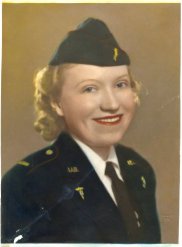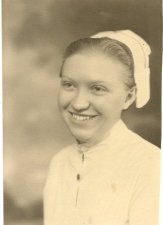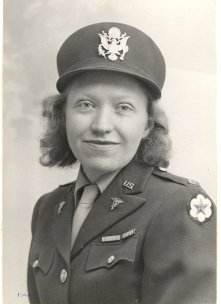RUTH E. LAUMBACH
May 13, 1914 ~ November 14,1995
A Memorial Day Tribute To a WWII Veteran
by Jan Girand

I received a surprising phone call from a staff member of the New Mexico Military Institute’s alumni office in February. Ms. Renée James-Bresson called on behalf of a female cadet, Miss Latimer. Both were searching for a close relative of Ruth E. Laumbach, who had served in the US Army during World War II. Both women wanted to return to the rightful owner the dog-tag they had acquired, and to learn more about the woman who had worn it.
Miss Latimer had noticed a young male cadet playing with the dog-tag; she looked at it and asked how he had acquired it. He said he found it in the tunnel under the Institute. The tunnel is a forbidden area to cadets; therefore, this cadet was in serious trouble and he would be investigated and the tunnel searched. Miss Latimer confiscated the tag and contacted Ms. James-Bresson at the alumni office to locate its rightful owner.
Both women had a long-time interest in females in the military, especially those of World War II, particularly women who “voluntarily remained behind to take care of our boys in the Philippines after World War Two ended,” Renée said. It seemed to me then that she had done some research into the wearer of the dog-tag, and had made serious effort to narrow her search to me.
The metal dog tag reads: “Ruth E. Laumbach, N-” followed by a six-digit number, “Dan Laumbach, Roy N Mex” along with another number, its significance I know not. From what little was stamped into the tag, she ultimately learned that Ruth was the daughter of Dan Laumbach of Roy, and that she had been an Army nurse during World War II. As alumni staff, was Renée able to research Ruth’s military record using her service number? I think she must have because of the remark she made about Ruth remaining behind in the Philippines after the war.
Renée took what would have been, to anyone else, a logical first step to locate me. She found a Roy phone number listing for R.E. Laumbach; I found even more amazing that she spoke to someone at that number who knew who Ruth was and my relationship to her. (Roy is a small village; only a few hundred people live in the entire Harding County. I knew some Laumbachs live there but I knew of none with initials R. E.) She said she spoke to a fellow named Rudy, who gave her my name and said she could reach me in Roswell. I have met Rudy (known to me as Sonny) briefly once or twice but I know who he is and on which family branch he belongs. He doesn’t live in Roy, but rather many miles from there, near Romeroville, close to Las Vegas. Serendipity? ?Quien sabe?
I received that inquiry call about Ruth with mixed emotions. I was touched that she and the cadet cared enough about Ruth–to them an unknown woman who’d worn that tag during the war long ago–to try to find its rightful owner and to know more about her. However, I was totally perplexed about how the tag came to be found in the tunnel under the Institute. I had an indirect connection with NMMI, but Ruth had none at all. My eldest son had been a high school graduate of NMMI more than 20 years earlier. For several years my husband, Dan, and I were ambassador parents to some fine male first- and second-class cadets, but that was before Ruth’s personal effects had been in our home. I had taken care of Ruth’s finances, had her power of attorney and was her caregiver the last years of her life. After her death, I searched for a meaningful home for her personal World War II memorabilia — including her uniforms and brass — to honor her memory. At that time, a friend of ours was curator of the NMMI McBride Museum and he said they planned to create a display of females in the military, especially since females had begun attending the Institute in 1978. Our friend said female memorabilia from the World War II era was uncommon, female disabled veterans of that war were even more rare. He was pleased to accept her items. (Soon thereafter, our friend left NMMI employ to attend law school.) I was pleased to think there would be a display at McBride Museum that might include some of Ruth’s possessions. Perhaps the manikin would even wear her uniform and her dog-tag. But, as far as I know, that display, with or without Ruth’s gear, is still pending.
Someone told me that the McBride Museum has been overwhelmed with uncatalogued military donations. I have also heard the McBride Museum has had break-ins, and their boxes of acquisitions rifled. From this, I guessed how Ruth’s dog-tag ended up in the tunnel under the Institute.
Ruth was born May 13, 1914 on her family’s remote ranch in San Miguel County, New Mexico, the next to youngest of seven siblings. She graduated from Roy High School in 1931, graduating from the St. Joseph Hospital Nursing Training School in Albuquerque, becoming certified as a registered nurse (RN) in New Mexico in 1937, and was also certified by the California State Board of Examiners in May 1940. She had gone to California to increase her medical training. She worked in the surgical ward.
 Then Pearl Harbor happened. Ruth was 27 years old. Her medical training and experience made her valuable at this time of war.
Then Pearl Harbor happened. Ruth was 27 years old. Her medical training and experience made her valuable at this time of war.
A few years after the war ended, in 1948 and 1949, she was additionally certified as a registered nurse in California after completing more training in Public Health Nursing at the University of Oregon Medical School.
However, the most significant portion of her life’s story falls between 1941 and 1948.
Ruth’s military records say she had gray eyes, was blonde, five-foot tall, and weighed between 95 and 105 pounds. Most of that was correct except her eyes were hazel and she was two inches taller. She was petite.
On June 30, 1941, she took her oath, joining the US Army at Letterman General Hospital, appointed to the Army Nurse Corps. One month later, she was assigned to active duty, as a 2nd Lt. On December 31, 1941, (24 days after Pearl Harbor was bombed and we had entered the war) she was assigned to an “extension of active Federal service for the period of the war and for the six (6) months immediately following its termination, unless sooner relieved by the President.” She was issued a steel helmet April 1942; gas mask and subsequent “gas chambers completed” May 1943. Between 1941 and 1944, among other duties, Ruth was an attending nurse assigned to travel between hospitals with some of the war’s first casualties shipped stateside. May 1945, she qualified with weapons and prepared to ship out to an undisclosed destination, “per Secret Movements,” according to her military records.
 Before she shipped out, her mother and sister, Verna, and small nephew, Jerry, traveled by train to San Francisco to say goodbye to Ruth. She crossed the continent by train and boarded a troop ship, departing USA shores, from Boston Harbor.
Before she shipped out, her mother and sister, Verna, and small nephew, Jerry, traveled by train to San Francisco to say goodbye to Ruth. She crossed the continent by train and boarded a troop ship, departing USA shores, from Boston Harbor.
She arrived in Liverpool, England, then proceeded to her next staging area, Llandudno, Wales. Moved again, in the 82nd General Hospital near Witchurch, England, she tended to her first overseas patients. In England she shared crowded quarters with seven other petite Army nurses; the soldiers dubbed it the Gremlin’s Hut because of its occupants’ diminutive size. She saw one of Bob Hope’s shows while serving in the European Theatre. On her first leave, she and her nurse friends went to Edinburgh, Scotland. She returned there on her second leave, and also went to London where she saw a young Princess Elizabeth.
On her journey to the Philippines, she transferred from an area near Derby, England to Southampton, crossed the Channel and arrived in La Harve, France. From there she went to Paris and then Marseille, another staging area. She left Marseille on a troop ship. From on-board, she saw Gibraltar, the coasts of Spain and Africa. Taking the southern route, she wrote in her diary, the journey took 43 days. She arrived in Panama in time to hear the news of the Japanese surrender. She left Panama, from shipboard saw the coast of South America, crossed the International Date Line and the equator, arrived in New Guinea and crossed the equator again, then went to Luzon Island in the Philippines. (I had to consult a globe to follow her route. Not only taking the southern route, the ship convoy tried to avoid shipping lanes where torpedoes were a known hazard.)
In the Philippines, she and other nurses were taken to a staging area where they were fenced in for their safety. Every day, someone with a sense of humor played a recording of “Don’t Fence Me In” over the loudspeaker. (Ironically, just a few years later, in 1947, that same song was played at the funeral of Ruth’s father, Dan Laumbach, in the little prairie town of Roy; it was one of his favorites.) Ruth and her fellow Army nurses took care of survivors of the Bataan Death March and other casualties of war. Snipers who did not know or chose to ignore news of the war’s end remained in the area. A fellow nurse was shot and killed by a sniper.
Ruth also became a casualty while stationed in the Philippines; she too was shot. However, the gun that shot and disabled her was an unexpected type, could even be labeled as “friendly fire.” She was shot with an inoculation gun. Years later, in the last months of her life, I read in her military papers that while in Luzon, PI, she had received “0.5 cc plague inoculation,” and a little more than a week later, she received “1.0 cc plague inoculation.” I thought that was the shot that did her in. But Ruth said, no, not that one. While she was in the Philippines, the Army had asked for volunteers to take a new experimental vaccine for the influenza killing tens of thousands of people. After receiving the shot, she had an immediate reaction, was unable to walk or use her arms. She was transferred to various hospitals until she was flown to Hawaii, then to stateside, ultimately ending up back at William Beaumont General, but as a patient, where she spent many months flat on her back. Whereas she had been a trained and experienced surgical nurse, requiring her to stand on her feet for hours, which she could no longer do, she was retrained, while still under a doctor’s care in the Army, as a public health nurse. She was promoted to 1st Lt. April 1945. She remained on sick leave until her final Army retirement, separation and medical discharge May 1947 with the rank of Captain.
Flu, like many other diseases, is no longer the dread disease it once was, thanks to medical technologies, efforts and heroism of many who dared risk their health if not their lives in times of peace as well as times of war.
Over the subsequent years, Ruth’s illness caused by that inoculation was diagnosed as different nerve disorders, including sciatic neuritis and peripheral neuropathy, degenerative disease of the nerves. She was a disabled World War II veteran, but received little Army compensation other than being retrained as a public health nurse so she could be a self-sufficient wage earner, which she was for decades while living in Bernalillo and Albuquerque.
She lived her last decade in Roswell near me, her last several years at Villa del Rey, a retirement complex.
At age 81, for recovery of a medical condition, the hospital temporarily placed her in a local nursing home. Just two days before she was scheduled to return to her apartment in Villa del Rey, one of the nursing home staff pushed her too fast, although there was no urgency, in her wheelchair with no foot rests in place. This was perhaps 10 a.m. that day. Ruth’s foot was caught and pulled back under the chair, she cried out, but the therapist was moving too fast to stop in time. Both bones below her knee snapped. I was told several staff were present at the nurses’ station near the incident and clearly heard the bones break. Still, they pushed her into her room, left her there to sit alone in her wheelchair, for many hours untended, feet dangling unsupported. Later that same day, after the nursing home had enough residents to fill a van to transport to the hospital for X-rays, she and others with suspected fractures were taken there by van in their wheelchairs, with only the van driver to attend them. He had no authority to make decisions. As was the nursing home’s policy at that time, the residents were not taken in through the emergency room entrance, were not seen by a physician, but taken directly to the radiation department. After X-rays, regardless what they showed, the van driver loaded the patients in their wheelchairs back into the van and drove them back to the nursing home–untreated and broken bones unstabilized. Unbelievable.
When I learned what had happened and, after searching futilely for Ruth at the hospital, I finally found her late in the day sitting alone in her wheelchair in her dark room at the nursing home, without the broken bones of her leg attended to, her feet dangling. One nurse’s aide had looked in and fulfilled Ruth’s plea; she placed a pillow under her foot to relieve some of the stress to her broken bones. When I found her, the pillow had slipped out from under her foot. It was after 8 p.m. that evening when–only because I insisted– she was returned, this time properly in a prone position in an ambulance, to the hospital and seen by a doctor, and her leg was put into a supportive soft cast.
For the next months, the nursing home continued to neglect Ruth in the same manner. I spend long hours and days with her; she would have had no care if I had not. (I also had my mother, nearly 87 years old, living at home with us.) During one of those periods, I was at Ruth’s bedside non-stop for 10 days and nights because she was in pulmonary crisis. (That crisis, said one doctor, was caused by a traveling clot caused by the broken bones.) I finally managed to get her out of the nursing home and back to her retirement village apartment, where she had 24-hour home health care. She survived several traumatic near-death events; at each one she fought to live. When her money was nearly gone and I knew she’d soon have to go onto Medicaid, the only option would be to put her back into a nursing home. I went to her one afternoon, sat at her bedside and wept, telling her this, asking her permission to discontinue home health care during the hours she slept to stretch what little money remained. She shook her head. “No.” She calmly patted my hand, told me to not cry. “It will be all right. It won’t matter. You’ll see.” A few hours later, she quietly died in her sleep.
(I could say much more about this nursing home … that it was filthy and all residents were seriously neglected … that a staff member had notified the State Health Department about what happened to Ruth … that the NM Attorney General became involved in her case, partly because the nursing home was charging Medicare for Ruth’s prolonged care when their carelessness had caused it … that for months, the nursing home was under investigation and had multiple unannounced state inspections and received mostly failing marks, all reported in the local newspaper … and that Ruth, and I on her behalf, sued the nursing home and won, but it was an empty victory because the wheels of justice grind exceedingly slow … by the time the case was settled, Ruth had died, my mother had died and between them their only other living sibling had died within six months of each other. There was no one important to me left for whom it would matter, except future nursing home residents. The only real victory I felt was that, soon after I had moved Ruth out of there and back into her retirement village apartment, the nursing home began to clean up its act and its premises, but still not nearly enough.)
This essay is to honor the life of Ruth, but it is also to illustrate the importance of family being attentive when a member is hospitalized or especially confined to a nursing home. And it is to illustrate what life is like for countless veterans who linger forgotten in nursing homes and veterans’ hospitals. Far too often, veterans’ health care is below the national average in quality, the best modern medicines are unavailable to them, their hospitals are crowded, poorly run, staffed and financed.
The reverse should be true but is not.
Our disabled and ill veterans deserve the very best care money can buy, and the very best hospitals should be theirs. Our veterans, who had offered their all for their country, deserve no less from us.
 Roswell Web Magazine
Roswell Web Magazine